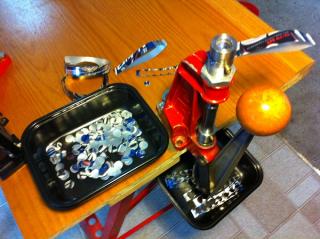OK all you Pat Marlin tool users, I seek solutions to my problem with a Checkmaker™ .40 caliber plain base gas check making tool.
No matter what "thin gauge" material I try to run through the die slot, it all jambs up. I am using coil material that is .625" wide. When I get the material to slide into the tool slot all seems well...until I punch the first check. The check punches fine but when I try to advance the strip for the next punch, it is wrinkled and jammed in the slot.
Here is what happens......when the punch cuts the disk and I return the press handle to lower the punch, the punch body drags on the strip and bends it down and twists it. When that happens the strip catches on the feed slot and will not allow one to advance or remove the strip. I have to rip the strip from the slot and clean it out. Pieces break off and lodge in the feed slot.
That is time consuming, say nothing of the frustration. I have tried polishing the slot with a diamond file, to no avail.
It works fine with the heavier gauge material but anything lighter than about .010" causes the hang-ups. It is especially bad with .004" to .007" material, (just the stuff needed for plain base checks). Maybe the strip material I am using is too narrow, and what is left after the disk is punched is too thin to have enough rigidity to hold the strip flat. I have tried the maximum width material that will fit into the slot and see if that cures the problem, (It did not).
I know it is not the fault of the material I'm using. I use many types and thicknesses' of aluminum, soft & half hard, as well as copper, soft & half hard. The jamming only happens with the thinner gauge materials.
I haven't been able to determined if it is a manufacturing defect in the tool or possible operator error, (I think not).
I have a standard Checkmaker™ tool in 32 caliber and a Freechex III tool in 40 caliber, neither of those give me any problem, only this Plain Base tool.
So, if anyone has a solution I would be appreciative of any suggestion. Thanks! Private message's also appreciated.......G

|
   
   
|


|





 Reply With Quote
Reply With Quote













